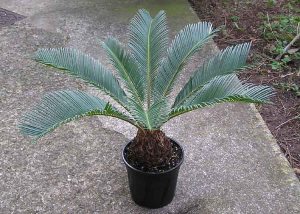Sago Palm a Danger to Pets
Veterinarians are warning pet owners that the sago palm plant is highly poisonous to dogs and cats. This is an outdoor ornamental plant in warm climates like here in San Diego, but also poses a health risk to pets when planted indoors in pots in colder climates.
What is the sago palm?
The sago palm belongs to the group of plants known as cycads, primitive palm-like plants that produce seeds and cones. They have thick short trunks and leaves that resemble ferns or palms. It also goes by the names king sago palm or Japanese sago palm.
Why is this plant dangerous?
All parts of the sago palm are toxic to dogs and cats. This includes the leaves, trunk, roots and especially the seeds. Other animals such as cows and horses, as well as children, are also at risk if they ingest parts of the sago palm. The main toxic element in the plant is called cycasin, which is a strong neurotoxin and also a carcinogen.
Many pet owners do not realize that the sago palm is so dangerous. One vet recently reported that a dog who played fetch with a sago palm seed pod died from acute liver failure.
What are the warning signs?
If your pet ingests any part of the sago palm, you can expect to see such symptoms as vomiting, diarrhea, lethargy, stumbling and seizures.
How is it treated?
There is no antidote for cycasin. Your vet will try to get the toxin out of your pet’s system by inducing vomiting or pumping the stomach. Additional care includes giving your pet IV fluids, anti-seizure medications, and other medications to prevent damage to the liver, gastrointestinal and nervous systems.
Sago palm poisoning is an acute veterinary emergency. If you suspect your pet has eaten sago palm, bring him or her to the vet immediately. Not all animals survive, and some may sustain long-term damage, but the sooner your pet is treated, the better.
For more information, click HERE.

